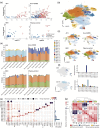Systematic Evaluation of Isolation Techniques and Freeze-Thaw Effects on Plasma Extracellular Vesicle Heterogeneity and Subpopulation Profiling
- PMID: 40575388
- PMCID: PMC12199058
- DOI: 10.1002/jex2.70058
Systematic Evaluation of Isolation Techniques and Freeze-Thaw Effects on Plasma Extracellular Vesicle Heterogeneity and Subpopulation Profiling
Abstract
Extracellular vesicles (EVs) are increasingly recognized as promising disease biomarkers and therapeutic carriers. However, standardizing blood-derived EV isolation remains challenging due to the heterogeneity of EV populations and variability among isolation techniques. In this study, we systematically evaluated three distinct EV isolation methods, including asymmetrical flow field-flow fractionation (AF4), size-exclusion chromatography (SEC) and automated centrifugal microfluidic disc system combined with functionalized membranes (Exo-CMDS), to compare their efficiency in isolating EVs from both freshly frozen and freeze-thawed plasma samples. We utilized an integrative approach combining Proximity-dependent Barcoding Assay (PBA) for single-EV surface protein profiling, Liquid Chromatography-Mass Spectrometry (LC-MS/MS) for bulk proteomic analysis, along with transmission electron microscopy (TEM) and nanoparticle tracking analysis (NTA) to assess EV yield, morphology, surface protein expression and subpopulation diversity. Our results revealed significant differences in three EV isolation methods. AF4 is particularly enriched for EV subpopulations expressing high levels of classical tetraspanins (e.g., CD81, CD9 and CD151), and single-pass membrane proteins (e.g., ITGA4 and ITAGB1). Exo-CMDS demonstrated the highest reproducibility across samples, isolating specific EV subpopulations enriched in markers like CD5. SEC provided the highest yield but co-isolated significant amounts of non-vesicular particles, including lipoproteins. The findings contribute valuable insights toward standardized and reliable EV isolation practices for research and clinical applications.
Keywords: EV isolation; extracellular vesicles; plasma; proteomics; single EV; small EVs; subpopulations; surfaceomics.
© 2025 The Author(s). Journal of Extracellular Biology published by Wiley Periodicals, LLC on behalf of the International Society for Extracellular Vesicles.
Conflict of interest statement
The authors declare no conflicts of interest.
Figures






Similar articles
-
Comprehensive characterization of human brain-derived extracellular vesicles using multiple isolation methods: Implications for diagnostic and therapeutic applications.J Extracell Vesicles. 2023 Aug;12(8):e12358. doi: 10.1002/jev2.12358. J Extracell Vesicles. 2023. PMID: 37563857 Free PMC article.
-
Most L1CAM Is not Associated with Extracellular Vesicles in Human Biofluids and iPSC-Derived Neurons.Mol Neurobiol. 2025 Aug;62(8):10427-10442. doi: 10.1007/s12035-025-04909-2. Epub 2025 Apr 10. Mol Neurobiol. 2025. PMID: 40210837 Free PMC article.
-
Analysis of biomarkers in speculative CNS-enriched extracellular vesicles for parkinsonian disorders: a comprehensive systematic review and diagnostic meta-analysis.J Neurol. 2024 Apr;271(4):1680-1706. doi: 10.1007/s00415-023-12093-3. Epub 2023 Dec 16. J Neurol. 2024. PMID: 38103086 Free PMC article.
-
Rigorous Comparison of Extracellular Vesicle Processing to Enhance Downstream Analysis for Glioblastoma Characterization.Adv Biol (Weinh). 2024 Jan;8(1):e2300233. doi: 10.1002/adbi.202300233. Epub 2023 Sep 5. Adv Biol (Weinh). 2024. PMID: 37670402 Free PMC article.
-
Revealing the Heterogeneity of Extracellular Vesicles: From Population to Single Particle Level.Proteomics. 2025 Aug 5. doi: 10.1002/pmic.70024. Online ahead of print. Proteomics. 2025. PMID: 40761132 Review.
References
LinkOut - more resources
Full Text Sources
